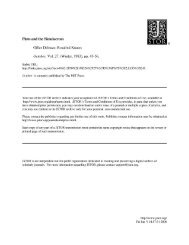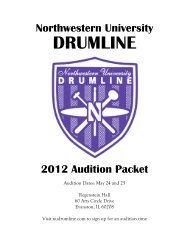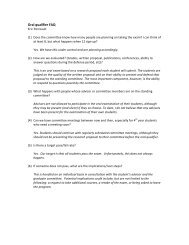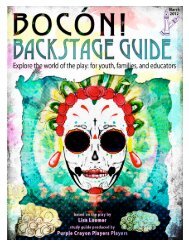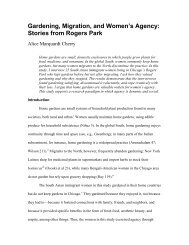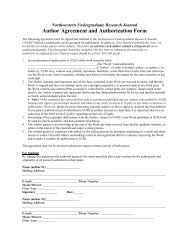research - Associated Student Government, Northwestern University
research - Associated Student Government, Northwestern University
research - Associated Student Government, Northwestern University
Create successful ePaper yourself
Turn your PDF publications into a flip-book with our unique Google optimized e-Paper software.
ABSTRACTWATCH WHAT YOU SAY:Spoken Self-Statements, Emotion, and BehaviorRichard ZinbargFACULTY ADVISORDEPARTMENT OF PSYCHOLOGYAlcina LidderDEPARTMENT OF PSYCHOLOGYPatricia M NielsenSECONDARY ADVISORANXIETY AND PANIC TREATMENT PROGRAMTHE FAMILY INSTITUTEWe all have said something negative about ourselvesat some point. An athlete might say, “Iwas so embarrassed that I missed that shot;I can’t play basketball again!” or a student may say, “Iwould die if I had to make a presentation in front of thewhole class!” Patients undergoing psychotherapy alsoroutinely use exaggerated negative self-statements (R.Zinbarg, personal communication, October 7, 2011). Apatient might say, “I could talk to my spouse about thatten years ago, but I can’t possibly do it now!” Clearly,these statements are not literally true and individualswho utter such hyperbolic statements do not alwaysmean for others to interpret the statements literally. Butdoes saying something negative about yourself make youfeel worse than saying something positive? Does saying“I can’t” make you less able to accomplish a goal than ifyou had said “I can”? The current study explores spokenpositive and negative self-statements (“I can” and “Ican’t”) and their effects on emotion and behavior.White-Schwoch (2011) examined spoken self-statementsin the context of blood-injection-injury (BII) fear.Individuals who have a high level of BII fear are afraidof seeing blood, a gory injury, getting an injection or acombination of any of these features and show disgust,avoidance, and/or fear as emotional reactions uponexposure (Bienvenu & Eaton, 1998; Cisler, Olatunji, &Lohr, 2008). Participants were randomly assigned toread statements with the words “I can” or “I can’t” aloud.For example, one statement set read: “If a TV show hasscenes with blood in them, I can still watch those scenes”and “If a TV show has scenes with blood in them, I can’twatch those scenes.” Not all statements related to BII fear,but all expressed the ability or inability to perform an action.Participants then performed a behavioral approachtask in which they viewed BII, positive, and neutral stimuli.In the “I can’t” condition, the greater the individual’slevel of BII fear, the less time he or she spent looking atthe BII images. But in the “I can” condition there wereno significant differences in looking times based on levelof BII fear. Curiously, differences in looking times betweenconditions were not limited to BII pictures.To explore the surprising results and determinewhether there is a localized effect of the spoken statementsto BII images, we modified White-Schwoch’sbehavioral approach task such that the stimuli weregrouped together in blocks based on valence. Participantswith varying levels of BII fear were randomly assignedto read the “I can” or “I can’t” statements aloud.They completed the modified behavioral approach taskand rated their affect following each image. Participants’facial expressions and looking times were recordedwhile they viewed the stimuli.Data has been collected from 140 participants.Looking time and affect rating results will be analyzedby repeated measures hierarchical linear regressions andvideos will be objectively coded for facial expressionsand movements that reflect disgust and/or avoidance.Similar to White-Schwoch, we expect a negative correlationbetween BII fear and BII stimuli looking timein the “I can’t” condition but no differences in the “Ican” condition. However, we expect a localized effect oflooking time differences to only BII stimuli. We anticipatethat those in the “I can’t” condition will rate theiraffect as less positive and more negative after viewingBII stimuli than those in the “I can” condition. Hence,we expect that negative self-statements will make a personfeel worse about viewing BII pictures than positiveself-statements. Moreover, we expect that those in the “Ican’t” condition will exhibit more instances of disgustand/or avoidance behavior while viewing BII imagesthan those in the “I can” condition.The study’s findings can inform clinical interventionwith psychotherapy patients who use hyperbolic negativelanguage when discussing their feared stimuli orevent. The results are also applicable to members of thegeneral public who use hyperbolic negative language ineveryday conversations.ReferencesBienvenu, O. J., & Eaton, W. W. (1998). The epidemiology of blood-injection-injury phobia.Psychological Medicine, 28(5): 1129-36.Cisler, J.M., Olatunji, B., & Lohr, J.M. (2008). Disgust sensitivity and emotion regulationpotentiate the effect of disgust propensity on spider fear, blood-injection-injury fear,and contamination fear. Journal of Behavior Therapy and Experimental Psychiatry,40(2): 219-29.White-Schwoch, T. (2011). Saying what we don’t mean: Spoken self-statements, affect, andemotional behavior. Unpublished manuscript.62 NORTHWESTERN UNDERGRADUATE RESEARCH JOURNAL




